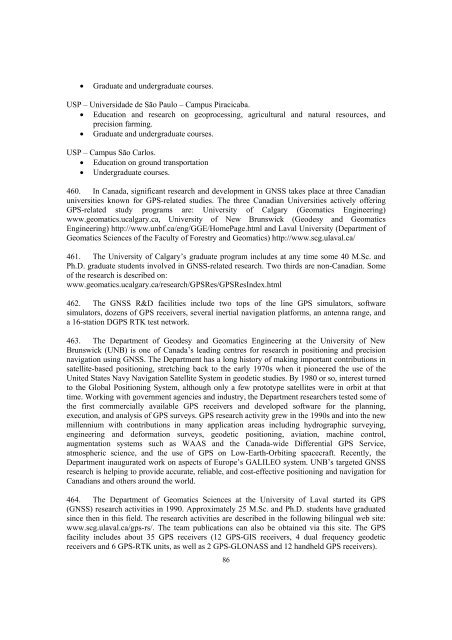• Graduate and undergraduate courses.USP – Universidade de São Paulo – Campus Piracicaba.• Educati<strong>on</strong> and research <strong>on</strong> geoprocessing, agricultural and natural resources, andprecisi<strong>on</strong> farming.• Graduate and undergraduate courses.USP – Campus São Carlos.• Educati<strong>on</strong> <strong>on</strong> ground transportati<strong>on</strong>• Undergraduate courses.460. In Canada, significant research and development in GNSS takes place at three Canadianuniversities known for GPS-related studies. The three Canadian Universities actively <str<strong>on</strong>g>of</str<strong>on</strong>g>feringGPS-related study programs are: University <str<strong>on</strong>g>of</str<strong>on</strong>g> Calgary (Geomatics Engineering)www.geomatics.ucalgary.ca, University <str<strong>on</strong>g>of</str<strong>on</strong>g> New Brunswick (Geodesy and GeomaticsEngineering) http://www.unbf.ca/eng/GGE/HomePage.html and Laval University (Department <str<strong>on</strong>g>of</str<strong>on</strong>g>Geomatics Sciences <str<strong>on</strong>g>of</str<strong>on</strong>g> <str<strong>on</strong>g>the</str<strong>on</strong>g> Faculty <str<strong>on</strong>g>of</str<strong>on</strong>g> Forestry and Geomatics) http://www.scg.ulaval.ca/461. The University <str<strong>on</strong>g>of</str<strong>on</strong>g> Calgary’s graduate program includes at any time some 40 M.Sc. andPh.D. graduate students involved in GNSS-related research. Two thirds are n<strong>on</strong>-Canadian. Some<str<strong>on</strong>g>of</str<strong>on</strong>g> <str<strong>on</strong>g>the</str<strong>on</strong>g> research is described <strong>on</strong>:www.geomatics.ucalgary.ca/research/GPSRes/GPSResIndex.html462. The GNSS R&D facilities include two tops <str<strong>on</strong>g>of</str<strong>on</strong>g> <str<strong>on</strong>g>the</str<strong>on</strong>g> line GPS simulators, s<str<strong>on</strong>g>of</str<strong>on</strong>g>twaresimulators, dozens <str<strong>on</strong>g>of</str<strong>on</strong>g> GPS receivers, several inertial navigati<strong>on</strong> platforms, an antenna range, anda 16-stati<strong>on</strong> DGPS RTK test network.463. The Department <str<strong>on</strong>g>of</str<strong>on</strong>g> Geodesy and Geomatics Engineering at <str<strong>on</strong>g>the</str<strong>on</strong>g> University <str<strong>on</strong>g>of</str<strong>on</strong>g> NewBrunswick (UNB) is <strong>on</strong>e <str<strong>on</strong>g>of</str<strong>on</strong>g> Canada’s leading centres for research in positi<strong>on</strong>ing and precisi<strong>on</strong>navigati<strong>on</strong> using GNSS. The Department has a l<strong>on</strong>g history <str<strong>on</strong>g>of</str<strong>on</strong>g> making important c<strong>on</strong>tributi<strong>on</strong>s in<strong>satellite</strong>-based positi<strong>on</strong>ing, stretching back to <str<strong>on</strong>g>the</str<strong>on</strong>g> early 1970s when it pi<strong>on</strong>eered <str<strong>on</strong>g>the</str<strong>on</strong>g> use <str<strong>on</strong>g>of</str<strong>on</strong>g> <str<strong>on</strong>g>the</str<strong>on</strong>g>United States Navy Navigati<strong>on</strong> Satellite System in geodetic studies. By 1980 or so, interest turnedto <str<strong>on</strong>g>the</str<strong>on</strong>g> Global Positi<strong>on</strong>ing System, although <strong>on</strong>ly a few prototype <strong>satellite</strong>s were in orbit at thattime. Working with government agencies and industry, <str<strong>on</strong>g>the</str<strong>on</strong>g> Department researchers tested some <str<strong>on</strong>g>of</str<strong>on</strong>g><str<strong>on</strong>g>the</str<strong>on</strong>g> first commercially available GPS receivers and developed s<str<strong>on</strong>g>of</str<strong>on</strong>g>tware for <str<strong>on</strong>g>the</str<strong>on</strong>g> planning,executi<strong>on</strong>, and analysis <str<strong>on</strong>g>of</str<strong>on</strong>g> GPS surveys. GPS research activity grew in <str<strong>on</strong>g>the</str<strong>on</strong>g> 1990s and into <str<strong>on</strong>g>the</str<strong>on</strong>g> newmillennium with c<strong>on</strong>tributi<strong>on</strong>s in many applicati<strong>on</strong> areas including hydrographic surveying,engineering and deformati<strong>on</strong> surveys, geodetic positi<strong>on</strong>ing, aviati<strong>on</strong>, machine c<strong>on</strong>trol,augmentati<strong>on</strong> <strong>systems</strong> such as WAAS and <str<strong>on</strong>g>the</str<strong>on</strong>g> Canada-wide Differential GPS Service,atmospheric science, and <str<strong>on</strong>g>the</str<strong>on</strong>g> use <str<strong>on</strong>g>of</str<strong>on</strong>g> GPS <strong>on</strong> Low-Earth-Orbiting spacecraft. Recently, <str<strong>on</strong>g>the</str<strong>on</strong>g>Department inaugurated work <strong>on</strong> aspects <str<strong>on</strong>g>of</str<strong>on</strong>g> Europe’s GALILEO system. UNB’s targeted GNSSresearch is helping to provide accurate, reliable, and cost-effective positi<strong>on</strong>ing and navigati<strong>on</strong> forCanadians and o<str<strong>on</strong>g>the</str<strong>on</strong>g>rs around <str<strong>on</strong>g>the</str<strong>on</strong>g> world.464. The Department <str<strong>on</strong>g>of</str<strong>on</strong>g> Geomatics Sciences at <str<strong>on</strong>g>the</str<strong>on</strong>g> University <str<strong>on</strong>g>of</str<strong>on</strong>g> Laval started its GPS(GNSS) research activities in 1990. Approximately 25 M.Sc. and Ph.D. students have graduatedsince <str<strong>on</strong>g>the</str<strong>on</strong>g>n in this field. The research activities are described in <str<strong>on</strong>g>the</str<strong>on</strong>g> following bilingual web site:www.scg.ulaval.ca/gps-rs/. The <str<strong>on</strong>g>team</str<strong>on</strong>g> publicati<strong>on</strong>s can also be obtained via this site. The GPSfacility includes about 35 GPS receivers (12 GPS-GIS receivers, 4 dual frequency geodeticreceivers and 6 GPS-RTK units, as well as 2 GPS-GLONASS and 12 handheld GPS receivers).86
465. Many o<str<strong>on</strong>g>the</str<strong>on</strong>g>r GNSS-related educati<strong>on</strong> and training opportunities exist in Canada and are<str<strong>on</strong>g>of</str<strong>on</strong>g>fered by o<str<strong>on</strong>g>the</str<strong>on</strong>g>r academic instituti<strong>on</strong>s and <str<strong>on</strong>g>the</str<strong>on</strong>g> GNSS-related industry in support to <str<strong>on</strong>g>the</str<strong>on</strong>g> manyapplicati<strong>on</strong>s enabled through GNSS.466. In Chile, <str<strong>on</strong>g>the</str<strong>on</strong>g> Universidad de C<strong>on</strong>cepción <str<strong>on</strong>g>of</str<strong>on</strong>g>fers a course <strong>on</strong> Geodesy and GNSS,Surveying and Applicati<strong>on</strong>s. This course’s cost is just 20% with student’s assistance and 80% bydistance. The focus <str<strong>on</strong>g>of</str<strong>on</strong>g> <str<strong>on</strong>g>the</str<strong>on</strong>g> course is to increase knowledge <strong>on</strong> GNSS technologies for positi<strong>on</strong>ingand engineering applicati<strong>on</strong>s, such as forestry, mining, car tracking and deformati<strong>on</strong> structure.467. In Germany, <str<strong>on</strong>g>the</str<strong>on</strong>g> list <str<strong>on</strong>g>of</str<strong>on</strong>g> universities that <str<strong>on</strong>g>of</str<strong>on</strong>g>fer training in GNSS can be found in Annex IIat <str<strong>on</strong>g>the</str<strong>on</strong>g> end <str<strong>on</strong>g>of</str<strong>on</strong>g> this <str<strong>on</strong>g>report</str<strong>on</strong>g>.468. Ind<strong>on</strong>esia <str<strong>on</strong>g>of</str<strong>on</strong>g>fers training opportunities in GNSS based at <str<strong>on</strong>g>the</str<strong>on</strong>g> Department <str<strong>on</strong>g>of</str<strong>on</strong>g> GeodeticEngineering Institute <str<strong>on</strong>g>of</str<strong>on</strong>g> Technology. The courses <str<strong>on</strong>g>of</str<strong>on</strong>g>fered cover <str<strong>on</strong>g>the</str<strong>on</strong>g> following fields:• Positi<strong>on</strong>ing by GPS: C<strong>on</strong>cepts and Theory;• GPS Survey: Planning, Executi<strong>on</strong> and Data Processing;• The Use <str<strong>on</strong>g>of</str<strong>on</strong>g> GPS for Cadastral Surveys;• The Use <str<strong>on</strong>g>of</str<strong>on</strong>g> GPS for Forest Survey and Mapping; and• The Use <str<strong>on</strong>g>of</str<strong>on</strong>g> GPS Survey for Natural Hazard Mitigati<strong>on</strong>.469. In Italy, <str<strong>on</strong>g>the</str<strong>on</strong>g>re are many universities skilled in <strong>satellite</strong> navigati<strong>on</strong> that also performtraining activities. The Italian Space Agency (ASI) organises disseminati<strong>on</strong> and traininginitiatives (see Annex III).470. In Malaysia, <str<strong>on</strong>g>the</str<strong>on</strong>g> University <str<strong>on</strong>g>of</str<strong>on</strong>g> Technology, through <str<strong>on</strong>g>the</str<strong>on</strong>g> Department <str<strong>on</strong>g>of</str<strong>on</strong>g> GeomaticEngineering, teaches subjects <strong>on</strong> <strong>satellite</strong> navigati<strong>on</strong> and GNSS surveying for Bachelors degree ingeomatic engineering and postgraduate programmes (Master <str<strong>on</strong>g>of</str<strong>on</strong>g> Science and Ph.D.). Added to <str<strong>on</strong>g>the</str<strong>on</strong>g>programmes are also <strong>satellite</strong> navigati<strong>on</strong> and GNSS surveying. This is d<strong>on</strong>e through researchwork and also several short courses <strong>on</strong> GNSS navigati<strong>on</strong>, positi<strong>on</strong>ing and surveying for relatedgovernment agencies and o<str<strong>on</strong>g>the</str<strong>on</strong>g>r organizati<strong>on</strong>s The Nati<strong>on</strong>al Land and Survey Institute (INSTUN),under <str<strong>on</strong>g>the</str<strong>on</strong>g> Ministry <str<strong>on</strong>g>of</str<strong>on</strong>g> Land and Cooperative Development, provides short trainings for GNSSapplicati<strong>on</strong>s.471. C<strong>on</strong>cerning activities in Poland, <str<strong>on</strong>g>the</str<strong>on</strong>g> paper entitled “Independent atomic time scale inPoland – Organizati<strong>on</strong> and results” (J. Azoubib, J. Nawrocki and W. Lewandowsk) elaborated <strong>on</strong><str<strong>on</strong>g>the</str<strong>on</strong>g> Polish infrastructure in <str<strong>on</strong>g>the</str<strong>on</strong>g> related field. The Polish independent atomic time scale TA (PL)<str<strong>on</strong>g>of</str<strong>on</strong>g>ficially started <strong>on</strong> 4 July 2001. It is currently based <strong>on</strong> <str<strong>on</strong>g>the</str<strong>on</strong>g> indicati<strong>on</strong>s <str<strong>on</strong>g>of</str<strong>on</strong>g> nine clocks fromseveral Polish laboratories and Lithuania. The clocks at <str<strong>on</strong>g>the</str<strong>on</strong>g> laboratories are compared using TTS-2 multi-channel GPS receivers developed in co-operati<strong>on</strong> with <str<strong>on</strong>g>the</str<strong>on</strong>g> Bureau Internati<strong>on</strong>al des Poidset Mesures (BIPM). The participating instituti<strong>on</strong>s are linked to <str<strong>on</strong>g>the</str<strong>on</strong>g> Central Office <str<strong>on</strong>g>of</str<strong>on</strong>g> Measures(GUM) in Warsaw. TA (PL) is computed as a weighted average <str<strong>on</strong>g>of</str<strong>on</strong>g> <str<strong>on</strong>g>the</str<strong>on</strong>g> participating clocks. Thepaper presented <str<strong>on</strong>g>the</str<strong>on</strong>g> clock ensemble, <str<strong>on</strong>g>the</str<strong>on</strong>g> data processing outline, and some experimental results.472. The paper c<strong>on</strong>cluded that <str<strong>on</strong>g>the</str<strong>on</strong>g> results obtained, especially <str<strong>on</strong>g>the</str<strong>on</strong>g> l<strong>on</strong>g-term stability <str<strong>on</strong>g>of</str<strong>on</strong>g> TA(PL), were quite satisfactory. The simplest way to improve stability was to add more clocks. Tw<strong>on</strong>ew clocks, <strong>on</strong>e at <str<strong>on</strong>g>the</str<strong>on</strong>g> Tele-Radio Research Institute in Warsaw and <str<strong>on</strong>g>the</str<strong>on</strong>g> o<str<strong>on</strong>g>the</str<strong>on</strong>g>r at <str<strong>on</strong>g>the</str<strong>on</strong>g> DevelopmentCenter <str<strong>on</strong>g>of</str<strong>on</strong>g> Polish Telecom were already working and being tested. Two more, from ano<str<strong>on</strong>g>the</str<strong>on</strong>g>rTelecom laboratory, were expected to be added before <str<strong>on</strong>g>the</str<strong>on</strong>g> end <str<strong>on</strong>g>of</str<strong>on</strong>g> 2003. The short-term stability87
















